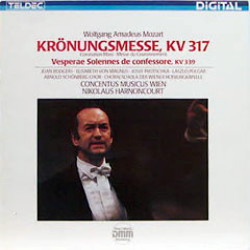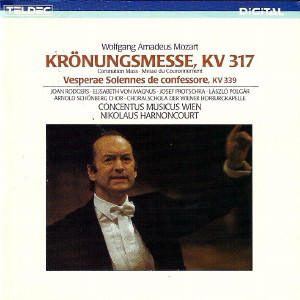 |
1 LP -
6.43535 AZ - (p) 1987
|
 |
| 1 CD -
8.43535 ZK - (p) 1987 |
|
| Wolfgang
Amadeus Mozart (1756-1791) |
|
|
|
|
|
|
|
| Missa in C-dur, KV 317
"Krönungsmesse" |
|
25' 52" |
|
| - Kyrie: Andante maestoso -
Più andante - Andante maestoso |
2' 57" |
|
A1 |
| - Gloria: Allegro
con spirito |
4' 34" |
|
A2 |
| - Credo: Allegro
molto - Adagio - Tempo I |
6' 17" |
|
A3 |
| - Sanctus: Andante maestoso -
Allegro assai |
1' 51" |
|
A4
|
| - Benedictus: Allegretto -
Allegro assai |
3' 36" |
|
A5 |
| - Agnus Dei: Andante
sostenuto - Andante con moto - Allegro
con spirito |
6' 37" |
|
A6 |
| Vesperae solennes de
confessore, KV 339 |
|
31' 36" |
|
| - I. Dixit: Allegro vivace
- Deus, in adjutorium meum intende -
(Antiphon: Domine, quinque talenta) |
5' 43" |
|
B1 |
- II. Confitebor: Allegro
- (Antiphon: Euge serve bone)
|
5' 11" |
|
B2 |
| - III. Beatus vir: Allegro
vivace - (Antiphon: Fidelis servus
et prudens) |
5' 17" |
|
B3 |
| - IV. Laudate pueri: (Alla
breve) - (Antiphon: Beatus ille
servus) |
4' 14" |
|
B4 |
| - V. Laudate Dominum: Andate
ma un poco sostenuto - (Antiphon:
Serve bone et fidelis) |
4' 42" |
|
B5 |
| - VI. Magnifikat: Adagio-Allegro
- (Antiphon: Hic vir, despiciens mundum)
- Benedicamus |
6' 29" |
|
B6 |
|
|
|
|
Joan Rodgers,
Sopran
|
|
Elisabeth von
Magnus, Alt
|
|
Josef Protschka,
Tenor
|
|
László Polgar,
Baß
|
|
|
|
Arnold-Schönberg-Chor
/ Erwin Ortner, Leitung
|
|
Choralschola der
Wiener Hofburgkapelle / P.
Hubert Dopf, Leitung
|
|
|
|
Concentus Musicus
Wien (mit
Originalinstrumenten)
|
|
| -
Erich Höbarth, Violin |
-
Eduard Hruza, Kontrabaß |
|
| -
Alice Harnoncourt, Violin |
-
Andrew Ackerman, Kontrabaß |
|
| -
Andrea Bischof, Violin |
-
David Reichenberg, Oboe |
|
| -
Peter Schoberwalter, Violin |
-
Marie Wolf, Oboe |
|
| -
Karl Höffinger, Violin |
-
Alberto Grazzi, Fagott |
|
| -
Helmut Mitter, Violin |
-
Elmar Eisner, Horn |
|
| -
Anita Mitterer, Violin |
-
Alois Schlor, Horn |
|
| -
Walter Pfeiffer, Violin |
-
Ernst Hoffman, Posaune |
|
| -
Peter Matzka, Violin |
-
Josef Ritt, Posaune |
|
| -
Annemarie Ortner, Violin |
-
Horst Küblböck, Possaune |
|
| -
Gerold Klaus, Violin |
-
Karl Steininger, Trompete |
|
| -
Peter Schoberwalter jun., Violin |
-
Hermann Schober, Trompete |
|
| -
Rudolf Leopold, Violoncello |
-
Michael Vladar, Pauken |
|
| -
Herwig Tachezi, Violoncello |
-
Herbert Tachezi, Orgel |
|
|
|
| Nikolaus
Harnoncourt, Leitung |
|
|
|
Luogo
e data di registrazione
|
Casino
Zögernitz, Vienna (Austria) - dicembre 1986
|
|
Registrazione
live / studio
|
| studio |
Producer
/ Engineer
|
-
|
Prima Edizione CD
|
| Teldec
- 8.43535 ZK - (1 cd) - 57' 55" - (p)
1987 - DDD |
Prima
Edizione LP
|
Teldec - 6.43535
AZ - (1 lp) - 57'
55"
- (p) 1987 - Digital
|
|
| Notes |
Mozart
was not a happy man when he had to
return to the employ of Hieronymus
Colloredo, the Archbishop of Salzburg,
on l5th January I779. The trip lasting
more than a year to Mannheim and Paris
had brought him important friendships
with other composers in Mannheim, but
also a series of failures,
disappointments and blows of fate.
Mozart’s mother had died in Paris,
Aloysia Weber had refused his offer of
marriage in Mannheim. All his attempts
to gain a foothold as a composer in
Munich, Mannheim or Paris had been
without success. After a journey that
began so promisingly, the 23-year-old
composer had no choice but to return to
his native Salzburg, to the house of his
father and to the service of a master he
disliked - the first major defeat of his
life.
For one thing was becoming increasingly
clear to Mozart since the visit to
Paris: the life of a free artist seemed
to suit him better, notwithstanding all
the financial difficulties involved,
than a secure job with a prince whose
wishes he had to bow to, although he did
not recognise him as his master. “The
Archbishop cannot pay me enough for the
slavery in Salzburg!” And “the
Archbishop had better not start to lord
it with me as he used to - I might just
thumb my nose at him!” Thus Mozart in a
letter to his father, when it became
evident that the return to Salzburg was
unavoidable. He hated his home town, and
it crippled his imagination to write for
audiences who showed no interest in his
music. “You can believe me that I prefer
working to idling around”, Mozart wrote
to his father in May 1781. “In Salzburg,
I have admit, I had to forcc myself to
work, and only just managed it. Why?
Because I wasn’t in good spirits.”
One of the first works from Mozart’s
“feudal service” in Salzburg, which was
brought to an aprupt end on 8th June
l78l when the palace chef Count Arco
kicked him out of the archiepiscopal
chambers, was the Mass in C major K.
3l7, the socalled “Coronation Mass”.
Mozart completed the work on 23rd March
1779. The title presumably refers to the
coronation of the Madonna in the
pilgrimage church of Maria am Plain near
Salzburg, a celebration that was carried
out every year with great pomp and
display. In June l75l the Pope himself
had even consecrated the precious crown
of the Virgin.
The Coronation Mass was Mozart’s ninth
mass in the key of C major. Although it
reflects the taste of the
Prince-Archbishop in its concise
simplicity, with for the most part
homophonic choral movements, the musical
impressions left by the trip to Mannheim
and Paris are clearly in evidence. In
comparison with the earlier masses, the
orchestral treatment is more highly
differentiated, although there are no
violas and the choruses are accompanied
by three trombones, in accordance with
Salzburg tradition. Also, the desire to
achieve a stricter formal structure for
the mass setting can be seen. For
example, Mozart takes up the theme of
the “Kyrie” again right at the end of
the Mass in the “Dona” and rounds off
the liturgical work musically in terms
of motifs. All the other movements have
the same formal consistency, which was
not customary in the earlier masses. The
“Gloria” is based on a three-part form
with the “Qui tollis” as the central
section. A rondo form is the basis of
the “Credo”. The “Sanctus” is held
together by an instrumental ostinato,
and the “Benedictus” also has a
three-part tendency - here Mozart
inserts the main idea once more as an
episode in the “Osanna”. Last of all,
the “Agnus Dei” underlines how little
distinction was made in Mozart’s time
between church music and opera: the
opening brings a clear reminder of the
Countess’s aria “Dove sono i mei
momenti” in The Marriage of Figaro.
The Vesperae solennes de confessore
K339, composed in August 1780, belong to
a different world. Where the Coronation
Mass is self-contained and consistent in
terms of key and motifs, each of the
psalms in the Vespers is given a
different musical character. These
psalms have only the tempo in common -
all movements are allegro with the
exception of the opening adagio pathos
of the Magnificat. The greatest contrast
is to be found between the two
consecutive psalms “Laudate pueri” and
“Laudate Dominum“. The former is a
choral fugue in strict contrapuntal
writing with a main theme which with its
jump of a diminished seventh documents
Mozart’s nascent interest in the
techniques of Baroque music. The latter
is a soloistic, almost unearthly
siciliano whose pastoral character is
emphasized by a solo bassoon marked “ad
libitum”.
Both the Coronation Mass and the
Vesperae solennes de confessore belong,
like liturgical music in general, to the
category of ‘utility music’ - music
intended to be heard only once, with
accordingly small interest in its
aritstic value. This makes it all the
more remarkable that Mozart wrote to his
father, when he made the acquaintance of
the music collection Baron van Swieten
in Vienna 1783, asking him to send him
the masses and vespers so that he could
perform them once more for a private
audience. “Only so that B. van Suiten
can hear him. He will sing discant; I
shall sing the alto and play at the same
time; Starzer will take the tenor part
and the boy Teyber from Italy the bass.
Please do send something soon - we look
forward to the musical meetings on
Sundays.” At a time when Mozart had
stopped writing church music, he
seperated his religious works from their
liturgical context and used them for
their musical value.
This recording goes back to the original
performing practice of the Vespers; in
the Vesper service each psalm was
introduced and followed by an antiphon -
this freaming suggets the sequence of a
number of` choral movements in allegro
tempo as a sensible musical solution.
Silke
Leopold
Translation:
Clive
Williams
|
|
Nikolaus
Harnoncourt (1929-2016)
|

|

|
|